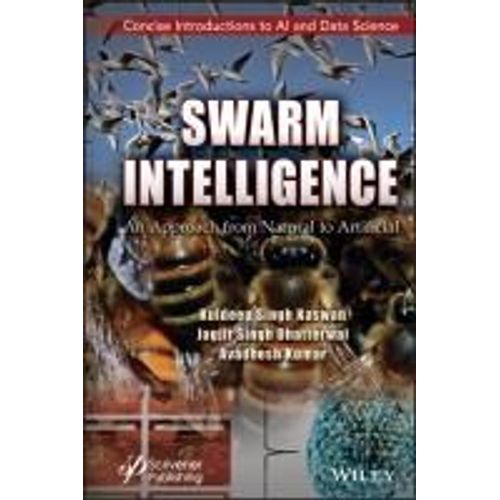

Swarm Intelligence - Kumar, Avadhesh
- Format: Relié
- 256 pages Voir le descriptif
Vous en avez un à vendre ?
Vendez-le-vôtreNos autres offres
-
196,54 €
Occasion · Comme Neuf
Ou 49,14 € /mois
- Livraison : 25,00 €
- Protection acheteurs :
- 0,00 €
Service client à l'écoute et une politique de retour sans tracas - Livraison des USA en 3 a 4 semaines (2 mois si circonstances exceptionnelles) - La plupart de nos titres sont en anglais, sauf indication contraire. N'hésitez pas à nous envoyer un e-... Voir plus
- Payez directement sur Rakuten (CB, PayPal, 4xCB...)
- Récupérez le produit directement chez le vendeur
- Rakuten vous rembourse en cas de problème
Gratuit et sans engagement
Félicitations !
Nous sommes heureux de vous compter parmi nos membres du Club Rakuten !
TROUVER UN MAGASIN
Retour

Avis sur Swarm Intelligence Format Relié - Livre
0 avis sur Swarm Intelligence Format Relié - Livre
Donnez votre avis et cumulez 5
Les avis publiés font l'objet d'un contrôle automatisé de Rakuten.
Présentation Swarm Intelligence Format Relié
- LivreAuteur(s) : Kumar, Avadhesh - Dhatterwal, Jagjit Singh - Kaswan, Kuldeep SinghEditeur : WileyLangue : AnglaisParution : 01/03/2023Format : Moyen, de 350g à 1kgNombre de pages :...

Résumé : Preface xi 1 Introduction of Swarm Intelligence 1 1.1 Introduction to Swarm Behavior 1 1.1.1 Individual vs. Collective Behaviors 1 1.2 Concepts of Swarm Intelligence 2 1.3 Particle Swarm Optimization (PSO) 2 1.3.1 Main Concept of PSO 3 1.4 Meaning of Swarm Intelligence 3 1.5 What Is Swarm Intelligence? 4 1.5.1 Types of Communication Between Swarm Agents 4 1.5.2 Examples of Swarm Intelligence 4 1.6 History of Swarm Intelligence 5 1.7 Taxonomy of Swarm Intelligence 6 1.8 Properties of Swarm Intelligence 10 1.8.1 Models of Swarm Behavior 11 1.8.2 Self-Propelled Particles 11 1.9 Design Patterns in Cyborg Swarm 12 1.9.1 Design Pattern Creation 14 1.9.2 Design Pattern Primitives and Their Representation 16 1.10 Design Patterns Updating in Cyborg 19 1.10.1 Behaviors and Data Structures 20 1.10.2 Basics of Cyborg Swarming 20 1.10.3 Information Exchange at Worksites 21 1.10.4 Information Exchange Center 22 1.10.5 Working Features of Cyborg 23 1.10.6 Highest Utility of Cyborg 24 1.10.7 Gain Extra Reward 25 1.11 Property of Design Cyborg 25 1.12 Extending the Design of Cyborg 31 1.12.1 Information Storage in Cyborg 32 1.12.2 Information Exchange Any Time 34 1.12.3 The New Design Pattern Rules in Cyborg 34 1.13 Bee-Inspired Cyborg 35 1.14 Conclusion 36 2 Foundation of Swarm Intelligence 37 2.1 Introduction 37 2.2 Concepts of Life and Intelligence 38 2.2.1 Intelligence: Good Minds in People and Machines 40 2.2.2 Intelligence in People: The Boring Criterion 41 2.2.3 Intelligence in Machines: The Turing Criterion 42 2.3 Symbols, Connections, and Optimization by Trial and Error 43 2.3.1 Problem Solving and Optimization 43 2.3.2 A Super-Simple Optimization Problem 44 2.3.3 Three Spaces of Optimization 45 2.3.4 High-Dimensional Cognitive Space and Word Meanings 46 2.4 The Social Organism 49 2.4.1 Flocks, Herds, Schools and Swarms: Social Behavior as Optimization 50 2.4.2 Accomplishments of the Social Insects 51 2.4.3 Optimizing with Simulated Ants: Computational Swarm Intelligence 52 2.5 Evolutionary Computation Theory and Paradigms 54 2.5.1 The Four Areas of Evolutionary Computation 54 2.5.2 Evolutionary Computation Overview 57 2.5.3 Evolutionary Computing Technologies 57 2.6 Humans - Actual, Imagined, and Implied 58 2.6.1 The Fall of the Behaviorist Empire 59 2.7 Thinking is Social 61 2.7.1 Adaptation on Three Levels 62 2.8 Conclusion 62 3 The Particle Swarm and Collective Intelligence 65 3.1 The Particle Swarm and Collective Intelligence 65 3.1.1 Socio-Cognitive Underpinnings: Evaluate, Compare, and Imitate 66 3.1.2 A Model of Binary Decision 68 3.1.3 The Particle Swarm in Continuous Numbers 70 3.1.4 Pseudocode for Particle Swarm Optimization in Continuous Numbers 71 3.2 Variations and Comparisons 72 3.2.1 Variations of the Particle Swarm Paradigm 72 3.2.2 Parameter Selection 72 3.2.3 Vmax 72 3.2.4 Controlling the Explosion 73 3.2.5 Simplest Constriction 73 3.2.6 Neighborhood Topology 74 3.2.7 Sociometric of the Particle Swarm 74 3.2.8 Selection and Self-Organization 76 3.2.9 Ergodicity: Where Can It Go from Here? 77 3.2.10 Convergence of Evolutionary Computation and Particle Swarms 78 3.3 Implications and Speculations 78 3.3.1 Assertions in Cuckoo Search 79 3.3.2 Particle Swarms Are a Valuabl...
Biographie: Kuldeep Singh Kaswan, PhD, is working in the School of Computing Science & Engineering, Galgotias University, Uttar Pradesh, India. He received his PhD in computer science from Banasthali Vidyapith, Rajasthan, and D. Engg. from Dana Brain Health Institute, Iran. His research interests are in brain-computer interface, cyborg, and data sciences. Jagjit Singh Dhatterwal, PhD, is an associate professor in the Department of Artificial Intelligence & Data Science, Koneru Lakshmaiah Education Foundation, Vaddeswaram, AP, India. He completed his doctorate in computer science from Mewar University, Rajasthan, India. He has numerous publications in international/national journals and conferences. Avadhesh Kumar, PhD, is Pro Vice-Chancellor at Galgotias University, India. He obtained his doctorate in computer science with a specialization in software engineering from Thapar University, Patiala, Punjab. He has more than 22 years of teaching and research experience and has published more than 40 research papers in SCI international journals/conferences. His research areas are aspect-oriented programming (AOP), software metrics, software quality, component-based software development (CBSD), artificial intelligence, and autonomic computing....
Sommaire: Discussed in the book are applications of various swarm intelligence models to operational planning of energy plants, modeling, and control of robots, organic computing, techniques of cloud services, bioinspired optimization, routing protocols for next-generation networks inspired by collective behaviors of insect societies and cybernetic organisms. Audience The book is directed to researchers, practicing engineers, and students in computational intelligence who are interested in enhancing their knowledge of techniques and swarm intelligence....
as well as applications and interesting experiences using particle swarm optimization, which is at the heart of computational intelligence.
Détails de conformité du produit
Personne responsable dans l'UE
